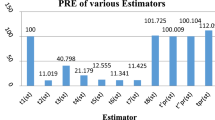Summary
The problem of stratification with proportional and optimum allocations in the case of simple random sampling has been examined in the light of an appropriate super-population model and a formal proof has been provided here for arranging the auxiliary character in increasing order of magnitude for stratification in the case of proportional allocation and also it is shown here that the same may not be necessary in the case of optimum allocation. However, if the coefficient of variation with respect to the auxiliary variate is same in each stratum the necessity of arraging the auxiliary character in increasing order of magnitude for stratification is established. The results are illustrated with respect to empirical examples. Also, some comparisons among different estimators have been made under the super-population model.
Similar content being viewed by others
References
Census of India (1961).District Census Hand Book, Kolhapur, 18–23. Maharashtra.
Census of India (1961).District Census Hand Book, Burdwan,11, 564–575. West Bengal.
Dalenius, T. (1950). The problem of optimum stratification—I,Skand Aktuarietidiskr.,33, 203–213.
Dalenius, T. (1952). The problem of optimum stratification, in a special type of design,Skand. Aktuarietidiskr. 35, 61–70.
Dalenius, T. and Gurney, M (1951). The problem of optimum stratification—II,Skand. Aktuarietidiskr.,34, 133–148.
Dalenius, T. and Hodges, J. L., Jr. (1957). The choice of stratification points,Skand. Aktuarietidiskr.,40, 198–203.
Dalenius, T. and Hodges, J. L., Jr. (1959). Minimum variance stratification,J. Amer. Statist. Ass.,54, 88–101.
Ekman, G. (1959). An approximation useful in univariate stratification,Ann. Math. Statist.,30, 219–229.
Govt. of India, Ministry of Food and Agriculture (1962).Maharashtra and Gujarat Agricultural Statistics 166–169.
Hanurav, T. V. (1965). Optimum sampling strategies and some related problems, Ph.D. Thesis, Indian Statistical Institute, Calcutta.
Isii, K. and Taga, Y. (1969). On optimal stratifications for multivariate distributions,Skand. Aktuarietidiskr., 1–2, 24–38.
Mahalanobis, P. C. (1952). Some aspects of the design of sample surveys,Sankhya,12, 1–7.
Raj, Des (1958). On the relative accuracy of some sampling techniques,J. Amer. Statist. Ass.,53, 98–101.
Rao, T. J. (1968). On the allocation of sample size in stratified sampling,Ann. Inst. Statist. Math.,18, 159–166.
Sethi, V. K. (1963). A note on optimum stratification of population,Aust. J. Statist.,5, 20–35.
Taga, Y. (1967). On optimum stratification for the objective variable based on concomitant variables using prior information,Ann. Inst. Statist. Math.,19, 101–129.
Vijayan, K. (1966). On Horvitz-Thompson and Des Raj estimators,Sankhya, A,28, 87–92.
Author information
Authors and Affiliations
About this article
Cite this article
Reddy, V.N. Stratified simple random sampling and prior distributions. Ann Inst Stat Math 28, 445–459 (1976). https://doi.org/10.1007/BF02504761
Received:
Revised:
Issue Date:
DOI: https://doi.org/10.1007/BF02504761




